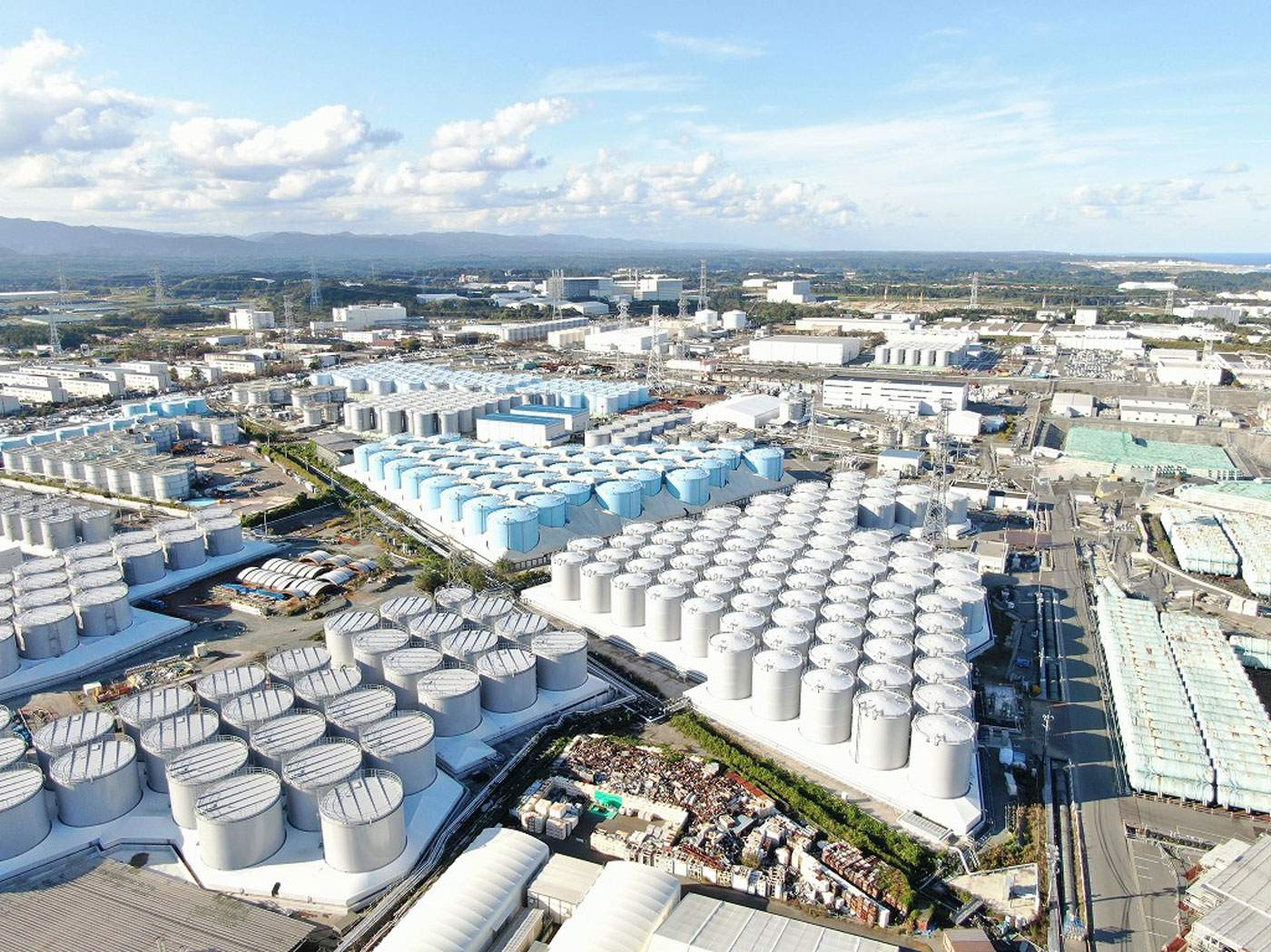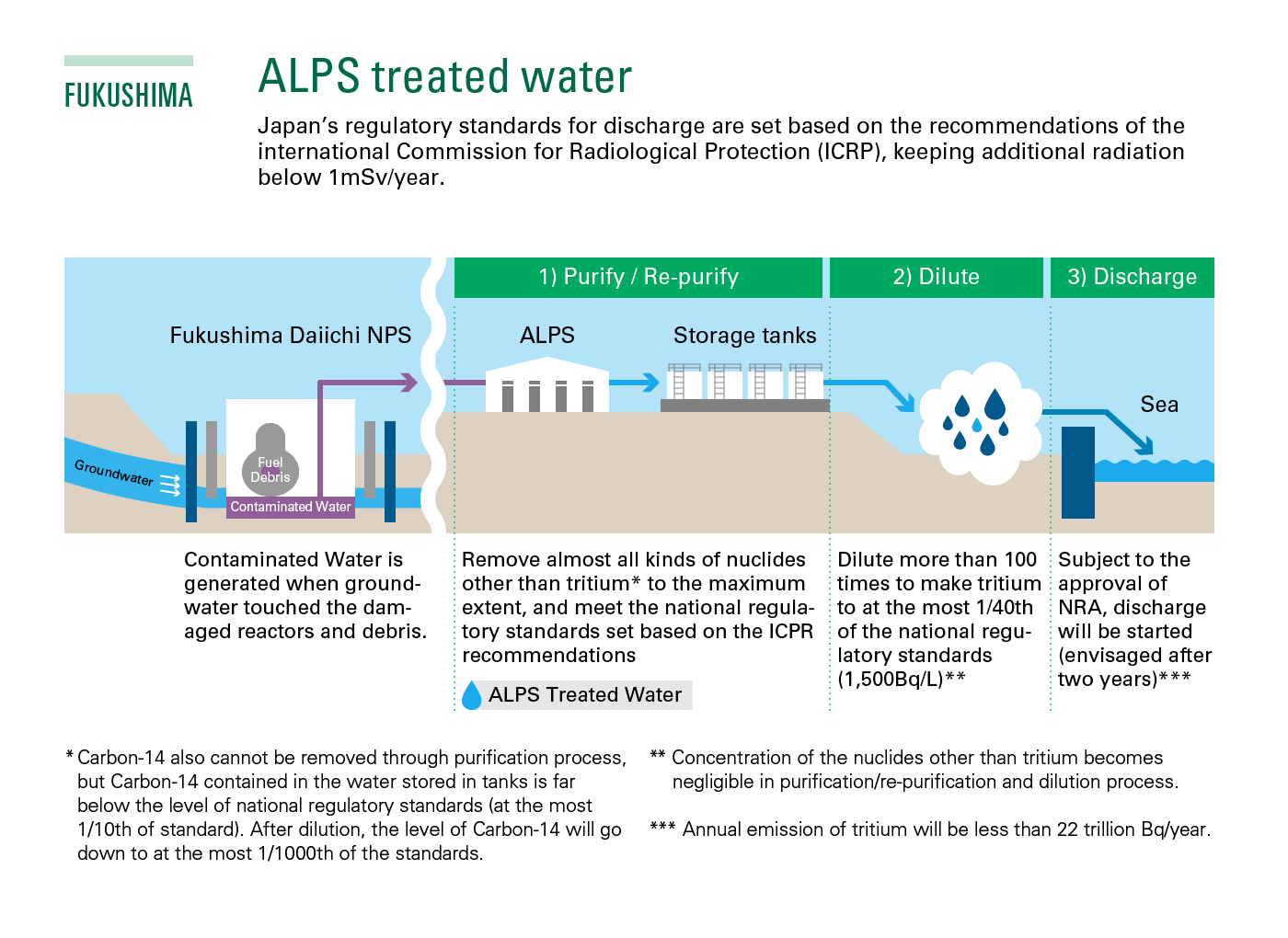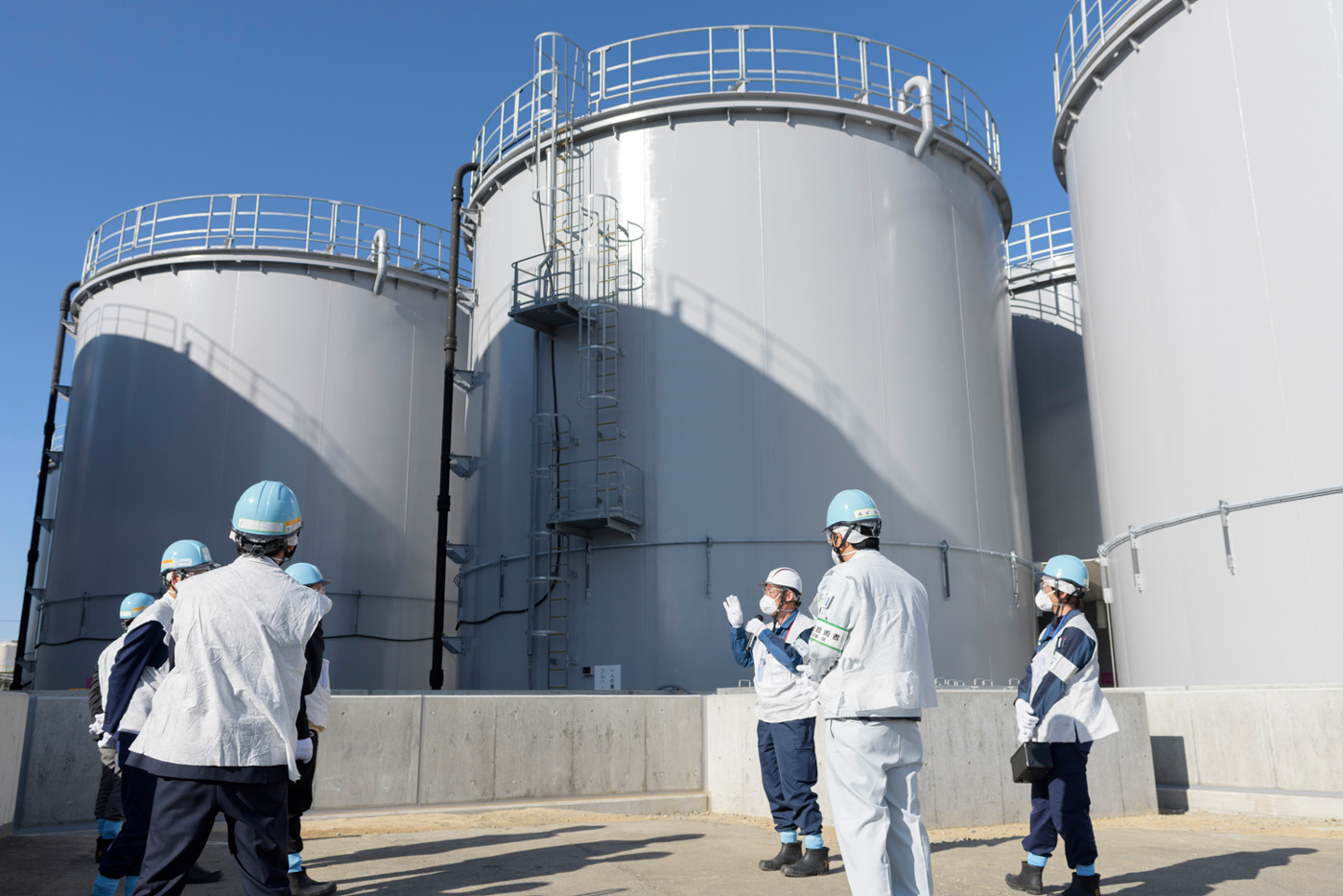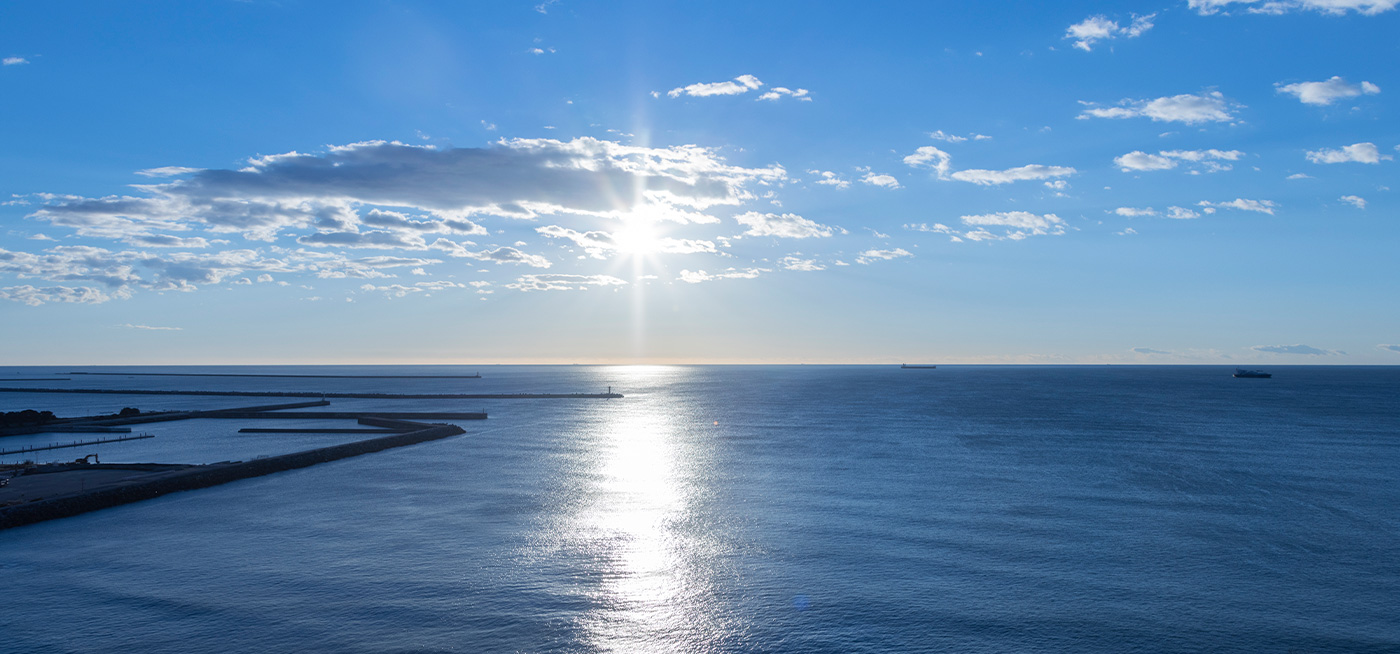In April of last year, the Japanese government announced plans to discharge treated water at Tokyo Electric’s (TEPCO) Fukushima Daiichi nuclear power plant into the sea. The water to be discharged has been treated through a filtration system called ALPS (Advanced Liquid Processing System) to remove radioactive materials, acquired through contact with the damaged reactors and fuel debris at the power plant, to below international regulatory standards for discharge.
The Japanese government’s decision has raised concerns about its environmental impact from environmental groups and neighbouring countries as well as further reputational damage to the disaster-affected areas. But the scientific evidence demonstrates that releasing the treated water is not only safe, but also a necessary and feasible solution. This view is held not just by the Japanese authorities and the plant operator, but by the United Nations’ nuclear agency and numerous independent international scientists.
The facts

On March 11, 2011, the Great East Japan Earthquake resulted in the triple disaster of earthquake, tsunami and nuclear accident in the northeast of the country. It was the strongest recorded earthquake in Japan and fourth in the world. The devastation was vast. A total of 19,729 people lost their lives. Approximately 470,000 people were evacuated from their homes. And economic damage amounted to some $235 billion, making it the costliest natural disaster in world history.
After a massive tsunami knocked out the cooling systems at the Fukushima Daiichi nuclear power plant, three of its reactors went into meltdown, creating melted fuel debris which remains in the reactor. Water subsequently used to cool the debris, along with rain and groundwater flowing into the site, has become contaminated with radioactive nuclides. Although contaminated water continues to be generated to this day, its generation has been effectively reduced by measures such as a frozen soil-wall in the ground to block groundwater from seeping into the contaminated areas and an impermeable sea-side steel wall to prevent leakage. The amount of contaminated water has fallen from an average 540 tonnes generated per day in 2014 to 140 tonnes in 2020.
This contaminated water is treated by the ALPS multi-nuclide removal equipment (developed by Toshiba and in use since 2013) to remove radioactive materials.

Already 1.28 million tonnes of ALPS treated water, which continues to be generated to this day, have accumulated in more than a thousand steel tanks at the site. These tanks are taking up a large area and restricting the construction of necessary facilities for the continued decommissioning of the power plant. Decommissioning is considered vital to ensure the ongoing reconstruction of the disaster-affected region, which in the past decade has seen remarkable progress in rebuilding infrastructure, reviving industries, and restoring normality to residents’ lives. After consultation with third parties over viable options, the government decided to discharge the treated ALPS water into the sea on the principles of safety and transparency.

Concerns about the discharge focus on the dangers of radioactive materials which remain in the treated water, a vast majority of which has been removed. But tritium, an isotope which emits weak radiation and has the same properties as hydrogen, is very difficult to remove from the water. Tritium exists in nature and can be found in rain, sea and tap water as well as inside of our bodies, but cannot accumulate in the human body.
By diluting the ALPS treated water to a hundredth of its concentration with seawater, the amount of tritium in the discharge will be less than 1,500 becquerels (a unit of radioactivity) per litre. The concentration represents 1/40 of that permitted under Japanese safety standards and around 1/7 of the World Health Organization’s (WHO) Guidelines for drinking water.
The total annual volume of tritium to be discharged will also fall below the operational target of the Fukushima Daiichi nuclear power plant before the accident (at 22 trillion becquerels per year). In fact, this figure is lower than the level of many nuclear facilities in operation today in Japan and elsewhere. At many nuclear facilities, tritium is routinely discharged into rivers and the sea or into the atmosphere through a ventilation process, in compliance with the laws and regulations of each country and region.
The Japanese government estimates the radiological impact of discharging the ALPS treated water to be “negligible”, less than 1/100,000 of the natural radiation exposure in Japan. Moreover, the areas in the sea where the tritium concentration in the water will exceed the background level (1 Bq/L) is estimated to be limited to within 2km from the nuclear power plant.
Besides tritium, around 70 per cent of all the tanks at the Fukushima Daiichi plant currently contain water with radionuclides such as strontium and caesium which exceed regulatory limits. Through additional ALPS treatment and dilution, the concentration of such nuclides other than tritium in the planned discharged water will be reduced to less than 1 per cent of regulatory standards.
IAEA monitoring and review
Supporting the Japanese government is the International Atomic Energy Agency (IAEA), the United Nation’s nuclear agency, which has agreed to monitor and review the discharge process.
“As the eyes of the international community, IAEA experts will be able to verify that the water discharge is conducted safely. This is of paramount importance to reassure people in Japan and elsewhere in the world, especially in neighbouring countries, that the water poses no threat to them,” IAEA Director General Rafael Mariano Grossi said in a statement in July 2021.
The IAEA had earlier reviewed a report published in 2020 by a Japanese government subcommittee of experts on the options for handling the treated water. In its review, the IAEA acknowledged that Japan’s chosen disposal method was “both technically feasible and in line with international practice” and that there were no known technologies which could separate out the tritium commensurate with the concentration and the volume of ALPS water.
In September, a task force under the IAEA which overseas the water discharge held its first meeting in Vienna. It includes not just IAEA staff, but eleven internationally recognised experts with diverse backgrounds from Argentina, Australia, Canada, China, France, the Marshall Islands, the Republic of Korea, the Russian Federation, the United Kingdom, the United States and Vietnam.
Since 2014, the IAEA has conducted missions to collect and monitor the levels of radiation in samples of seawater, marine sediment and fishery products from the coast near the plant. Inter-laboratory comparisons in the past have confirmed that Japanese laboratories produce reliable data of these samples. In 2021, laboratories from France, Germany and the Republic of Korea have participated in this annual IAEA-led marine monitoring project. Such independent and inter-laboratory marine monitoring will contribute to confidence building in the process of discharging ALPS water.
Evaluations by scientists
Numerous scientists in trusted academic journals and news sources have also commented on the discharge plans. The majority recognise both the safety and necessity of the plan to release treated water into the sea.
In April 2021, Science, published by the American Association for the Advancement of Science (AAAS), reported on the Japanese government’s decision. It quoted the Australian Science Media Centre’s view that by diluting the treated water, the “radioactivity can be reduced to safe levels” comparable to exposures from medical imaging and airline travel.
In May 2021, Nature, the esteemed international science journal, published a news article entitled: “Scientists OK plan to release one million tonnes of waste-water from Fukushima.” In the report, multiple scientists were interviewed. The majority perceived dangers to the environment to be minimal from the Japanese government’s plans. “Radiation in the treated waste-water will be very low, and that the water will be released gradually over several years to minimize any risk,” the article noted.
Earlier in 2020, the London-based popular science magazine New Scientist asked four scientists based in European and US institutions about the discharge plans. None opposed the decision, although they called for close monitoring. One expert called the decision “a sensible option” and others viewed the radiological risk posed to the environment by tritium “relatively harmless” and “very small”.
Trusted news sites have also weighed in. In April 2021, the British Broadcasting Corporation (BBC) reported that the risk from ingesting tritium released from Fukushima is not zero, “but the scientific consensus is that it does not pose a threat to human health.”
More recently, a British environmental scientist interviewed in The Guardian said that “the sort of releases [of tritium] we’re talking about are radiation doses in the sort of microsievert range which is radiologically, I would call that insignificant.” He added that this is a “commonly held view among scientists.”
Most of the scientists quoted in these neutral media sources were in consensus about the safety of the discharge plans. Rather, the greater challenge was how to effectively communicate the scientific facts to a concerned public and prevent reputational damage, particularly to local fisheries.
Ongoing commitment to safe decommission
The decommissioning of the Fukushima Daiichi nuclear power plant is expected to take some 30 to 40 years since cold shutdown of the reactors was achieved in December 2011. A decade has passed. The process of lowering radiological risks as well as dismantling reactor facilities have progressed step by steady step.
Today, the radiation leaking outside the reactors is very limited, and no effects are expected from radiation exposure even at the site boundary. This means workers are wearing ordinary working clothes in 96 per cent of the site area. Last year, all spent nuclear fuel was successfully removed at Units 3 and 4, with preparations to start fuel removal underway at the remaining reactors.
The fundamental research necessary for decommissioning will accelerate with the creation of a new analysis and research centre of the Japan Atomic Energy Agency (JAEA) in Okuma town, next to the Fukushima Daiichi plant. JAEA’s site, currently under development, will conduct analyses of waste material to develop technologies to process and dispose of radioactive waste material as well as analyses of fuel debris to develop technologies to remove fuel debris through all its stages. In addition, the site will train technicians capable of carrying out these tasks. It is also expected to provide third-party monitoring of the planned ALPS water discharge into the sea.
In the coming decade, these challenging steps must continue under close monitoring and cooperation from the international community based on evidence and science. Both the Japanese government and TEPCO are fully committed to such safe and steady decommission.
